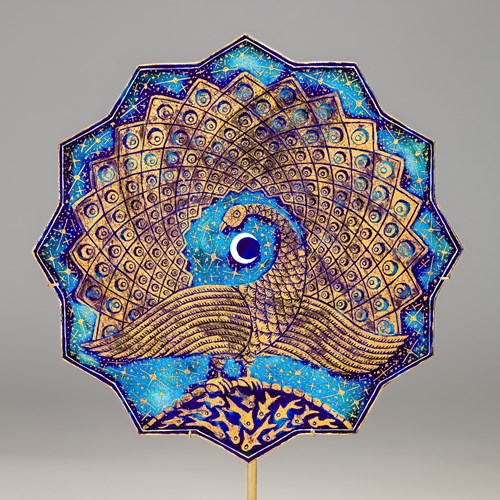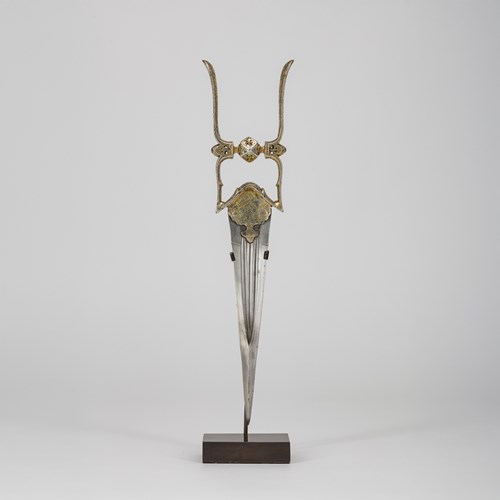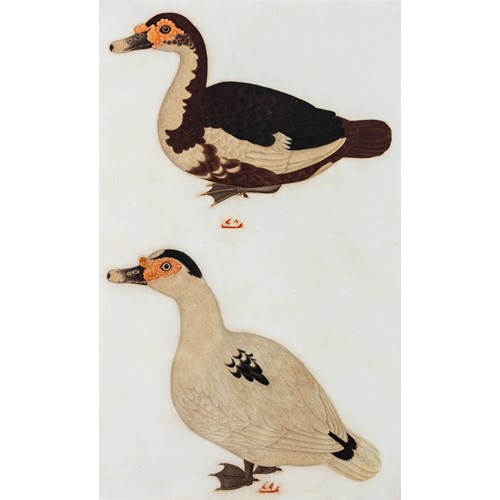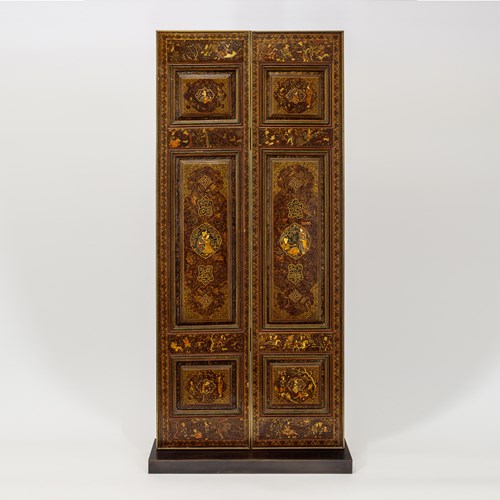Marketplace
SAFAVID LUSTRE BOWL
This fritware bowl is a fine example of a group of objects made between 1650 and 1700 during a brief revival of Persian lustreware production. During the 12th, 13th, and early 14th centuries, centres such as Kashan had produced lustre ceramics, but the technique had been lost following the Mongol invasion. After an initial firing, dense metallic oxide lustre was applied over a white or cobalt blue glaze. Bowls were commonly blue on the outside and white on the inside. On a second firing in the oxygen-deprived environment of the muffle kiln, the metallic compounds in the lustre break down, leaving a luminous metal deposit on the surface of the object. Copper oxide imparted a brownish colour, as in this case, Silver oxide imparts a golden colour, gold oxide colours varying from pale pink to lavender, and copper oxide a brownish colour, as in the case of this bowl.1
At the centre of the bowl is a cypress tree, flanked by plants growing on a riverbank. The cavetto is decorated with 11 architectural cartouches radiating from the central medallion, each holding a shield-like flower which are stylised irises.2 A characteristic rope pattern runs around the inside rim of the bowl. The outside is decorated with four quatrefoil escutcheons, inside which are two hatched circles. The spaces between each of these are filled with the river bank motif. The influence of Chinese porcelain, which is omnipresent in Safavid blue-and-white ceramics, is absent on these bowls.3 A bowl of similar form in the collection of the Victoria & Albert Museum (accession no. C.1965-1910) is glazed with cobalt blue on the outside and white on the inside. It shares decorative features such as irises on the inside of the bowl and the rope pattern running along the inside rim. A bowl in the collection of the Royal Ontario Museum, Toronto (accession no. 950.157.114) is similarly white on the inside and blue on the outside, this time with a pair of cypress trees on the central medallion.
1 Lane, Arthur. Later Islamic Pottery. London: Faber & Faber, 1957. P. 103.
2 Golombek, Lisa ‘Dominant Fashions and Distinctive Styles’, in Golombek et al. Persian Pottery in the First Global Age: The Sixteenth and Seventeenth Centuries. Vol 1. Brill: Leiden, 2014. Pp. 57-122, 115.
3 Lane. Op. cit. P. 103.
At the centre of the bowl is a cypress tree, flanked by plants growing on a riverbank. The cavetto is decorated with 11 architectural cartouches radiating from the central medallion, each holding a shield-like flower which are stylised irises.2 A characteristic rope pattern runs around the inside rim of the bowl. The outside is decorated with four quatrefoil escutcheons, inside which are two hatched circles. The spaces between each of these are filled with the river bank motif. The influence of Chinese porcelain, which is omnipresent in Safavid blue-and-white ceramics, is absent on these bowls.3 A bowl of similar form in the collection of the Victoria & Albert Museum (accession no. C.1965-1910) is glazed with cobalt blue on the outside and white on the inside. It shares decorative features such as irises on the inside of the bowl and the rope pattern running along the inside rim. A bowl in the collection of the Royal Ontario Museum, Toronto (accession no. 950.157.114) is similarly white on the inside and blue on the outside, this time with a pair of cypress trees on the central medallion.
1 Lane, Arthur. Later Islamic Pottery. London: Faber & Faber, 1957. P. 103.
2 Golombek, Lisa ‘Dominant Fashions and Distinctive Styles’, in Golombek et al. Persian Pottery in the First Global Age: The Sixteenth and Seventeenth Centuries. Vol 1. Brill: Leiden, 2014. Pp. 57-122, 115.
3 Lane. Op. cit. P. 103.
More artworks from the Gallery









